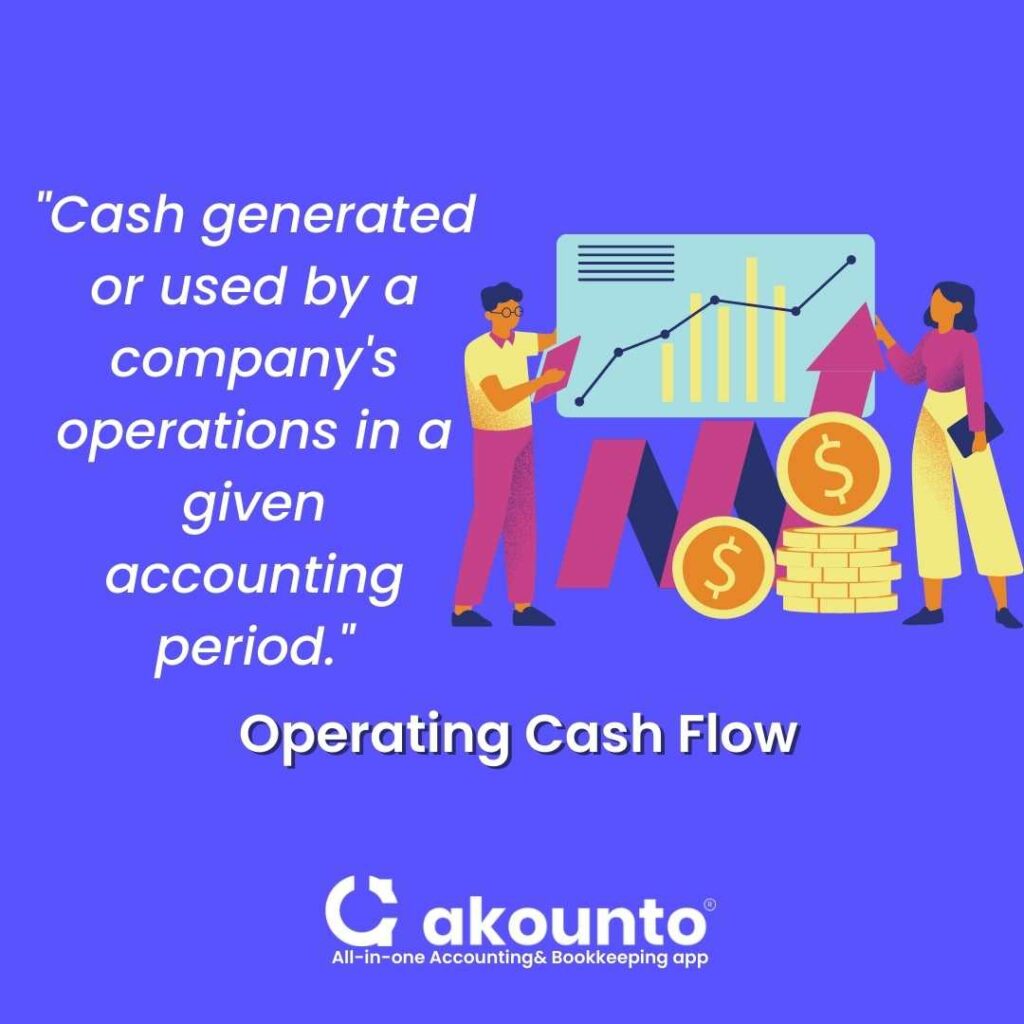What is Operating Cash Flow?
Operating cash flow refers to cash incoming and outgoing generated by core business activities in an accounting year.
What’s covered in the article
Operating cash flow is a component of the cash flow statement that records cash flow generated due to the following activities:
- Operating activities
- Investing activities
- Financing activities
Operating cash flow contributes to the “top line” of the business and is a part of revenue shown at the top of the income statement.

The company’s operating cash flow represents its operational efficiency in its day-to-day activities. The operating cash flow statement, the operating cash flow – ocf, is shown in the first section.
The impact of cash on the net income is gauged from operating cash flow related to the primary business activities or the core business operations.
Core business operations are business activities for which the business is incorporated. All the expenditures or income which are linked to business activities will come under operating activities, like:
Paying salaries and wages
Purchasing inventory
Cash receipts from the sale of:
Goods
Services
Cash collected from debtors and customers
Cash paid to the vendors
Payment of income tax
Royalty received
Sale or purchase of fixed assets, dividends paid or received, etc., are covered under investing activities. Similarly, payment of loans, issue of shares, and proceeds from long-term borrowings are covered under cash flow from investing activities.
People often confuse operating cash flow with free cash flow, but both differ.
Free cash flow subtracts CAPEX, i.e., the capital expenditures from the cash generated from business activities. Free cash flow helps determine an enterprise’s value, while operating cash flow helps measure efficiency in daily business operations.
Cash Flow Statements
A cash flow statement depicts changes in the business’s cash balance at the start and end date of an accounting period.
A cash flow statement is given along with the company’s financial statement to show the impact of operating, investing, and financing decisions on its liquidity during the accounting period.
Globally there is a widespread compliance requirement for International Financial Reporting Standards (IFRS). The US SEC (Securities and Exchange Commission) mandates domestically registered companies to apply GAAP (Generally Accepted Accounting Principles), whereas foreign entities can continue using IFRS given by International Accounting Standards Board (IASB).
ASC-230 (Accounting Standards Codification) in US GAAP pertains to cash flow statements, while in IFRS, the guidance for cash flow statements is given in IAS -7 (International Accounting Standard).
How to calculate operating cash flow?
As per US GAAP, there are two methods to calculate operating cash flow:
Direct method
Indirect method
US GAAP prefers the direct method, while the indirect method is predominant. If an entity uses the direct method, it must prepare a reconciliation report with the indirect method.
The indirect method is preferred because it is linked to the financial statements, including the income statement and balance sheet. At the same time, the direct method is useful in presenting investing and financial activities consistent with the available format.
Direct Method
The direct method for calculating operating cash flow groups all the cash transactions into receipts and payments. It makes the format detailed and easily understandable. Financial Accounting Standards Board (FASB) also promotes this method as it presents a comprehensive picture with deeper insights.
The direct method tracks actual cash inflows very similar to the cash accounting method, excluding any payables and receivables. The direct method lists all actual cash outflows and inflows, presenting a detailed view compared to the indirect method.
Operating cash flow calculation using the direct method:
Step 1: Determine cash inflows from operating activities: Like a cash basis, classify and determine cash received from the customers, including current cash sales and accounts receivable from past credit sales. Determine the cash received from customers.
Step 2: Determine cash outflow from operating activities: List all the cash payments made while procuring the goods, raw materials, payments to vendors, suppliers, accounts payables, etc.
Step 3: Operating expenses: Cash expenses are made as a part of operating expenses like rent, salaries, and other operating costs.
Step 4: Overall cash flow: By balancing the above inflows and outflows, the net cash flow from operating activities for a given accounting period is calculated.
Format and Formula of the direct method of operating cash flow calculation with an example of cash items
| Direct Method – OCF Calculation | ||
| Cash from operating activities | ||
| Cash received from customers | ||
| Sales Revenue | XXXX | |
| Net Accounts Receivable | (+/-) XXXX | |
| Deferred Revenue | XXXX | |
| Cash Paid to Suppliers | ||
| Cost of Goods Sold | – XXXX | |
| Payables | (+/-) XXXX | |
| Cash Purchase of Stock | (+/-) XXXX | |
| Cash for Operating Expenses | ||
| Salaries and Wages | (+/-) XXXX | |
| Prepaid Expenses | (+/-) XXXX | |
| Accrued Liabilities | (+/-) XXXX | |
| Other Cash Expenses | ||
| Taxes paid | (+/-) XXXX | |
| Interest paid | (+/-) XXXX | |
| Net Cash (Cash from Operations) | (+/-) XXXX | |
Examples of actual cash items for the direct method are:
Cash received from customers
Cash paid to vendors
Salaries paid to employees
Taxes paid
Indirect Method
The indirect method is a reverse method that starts with the net income and is adjusted for non-cash expenses and changes in the working capital to obtain operating cash flow. The changes in the working capital expenditure are also incorporated as net working capital.
The net income approach for calculating the operating cash flow ocf makes financial statements central to this approach.
The direct method provides a detailed view, while the indirect method provides a summarized view.
Operating Cash flow calculation using the indirect method:
Step 1: Operating cash flow ocf calculation begins with obtaining net income from the company’s income statement.
Step 2: Certain non-cash expenses like depreciation, provisions created for bad debts, and deferred taxes reduce the net income without impacting the cash flow because there is no real cash outflow.
Step 3: Net working capital calculation: The changes in the working capital is due to the changes in cash. Items like accounts receivable, accounts payable, inventory, etc., impact cash flows. If accounts receivable increased, this means that credit transactions have also increased and cash is not generated. Similarly increase in accounts payable reflects an increase in working capital. The net amount of the items is calculated and adjusted to the net income.
Step 4: The net impact of the items in steps 2 and 3 are adjusted to the net income to obtain the company’s net operating cash flow for a given period.
Format and Formula of indirect method of operating cash flow calculation with an example of non-cash expense items
| Indirect Method – OCF Calculation | ||
| Net Income (Taken from the income statement) | XXXX | |
| Adjustments to reconcile Net Income with Net Cash from Operating Activities | ||
| Add | Depreciation Expense | XXXX |
| Amortization Expense | XXXX | |
| Loss on Sale of Assets | XXXX | |
| Decrease in non-cash current assets | XXXX | |
| Increase in current liabilities | XXXX | |
| Deferred Taxes | XXXX | |
| Subtract | Increase in current assets other than cash | (XXXX) |
| Gain on Sale of Assets | (XXXX) | |
| Decrease in Current Liabilities | (XXXX) | |
| Net Cash Generated from Operations | +/- XXXX |
Importance of Operating Cash Flow
Knowledge of calculating operating cash flow is important not just for accountants but also for investors, analysts, auditors, and tax experts.
Getting deeper insights into the cash-generating efficiency of core business operations is important to gauge liquidity.
Apart from the liquidity, which is short-term in nature, the operating cash flow helps to assess the company’s solvency. Solvency is the company’s ability to cover or meet its financial obligations or pay off debt.
Solvency is a measure of long-term stability. A positive cash flow reflects the ability to generate enough cash from primary activities to pay off debts.
Over time, analysis of operating cash flow helps the small business identify the pattern and causes of the changes in financial stability and health.
For example, demand for goods leading to higher sales can result in increased cash flow, or the efficiency of the procurement department in minimizing buying cost of raw materials can also do the same.
While raising funds, analysis of cash flow is critical. A company may raise capital by raising debt, issuing equity, or capital infusion from the owners.
Knowing how much cash could be generated to meet stock-based compensation or any regular investment outflows is important.
Companies can gauge the operating efficiency of cash-generating and cash-collecting activities too. An accounts receivable increase will lead to a higher operating cash flow and comfortable working capital financing.
Lenders, creditors, and banks utilize the operating cash flow information to gauge the debt servicing capacity of the company. The financial performance in cash generation highlights the ability to repay its debts.
Operating Cash Flow vs. the Net Income
Operating cash flow and net income help gauge a business’s financial health. Still, the difference comes concerning the time of realization of revenue.
Following the accrual method of accounting and matching principle, the revenue will be recorded when the sale is made, irrespective of whether the cash transaction is settled.
Credit sales will increase net income, but operating cash flow does not consider credit sales. There is a possibility of a huge gap between operating cash flow and net income.
Net income also takes into account various non-cash expenses like depreciation expense that is created under accounting principles.
Operating cash flow is assessed to evaluate the company’s financial performance, and stakeholders can easily judge the liquidity and solvency of the business along with the efficiency of routine operations.
Akounto, an all-in-one accounting software, helps generate similar reports that help in a deeper analysis of a company’s financial health. Visit Akounto Website for more information.











